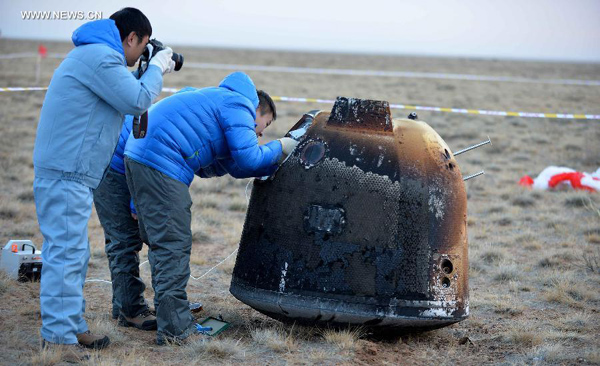|
 |
| Researchers retrieve the return capsule of China's unmanned lunar orbiter in the central region of North China's Inner Mongolia autonomous region, Nov 1, 2014. [Photo/xinhuanet.com] |
BEIJING -- China succeeded Saturday in the world's first mission to the Moon and back in some 40 years, becoming the third nation to do so after the former Soviet Union and the United States.
The test lunar orbiter, nicknamed "Xiaofei" on Chinese social networks, landed in Siziwang Banner of China's Inner Mongolia Autonomous Region early Saturday morning.
Search teams have already recovered the orbiter at the designated landing area, about 500 kilometers away from Beijing.
The last documented mission of this kind was by the Soviet Union in the 1970s.
Launched Friday last week, the orbiter traversed 840,000 kilometers on its eight-day mission that saw it round the far side of the Moon and take some incredible pictures of Earth and Moon together.
The re-entry process began at around 6:13 a.m. Saturday morning, with the orbiter approaching Earth at a velocity of about 11.2 kilometers per second.
The high speed led to hefty friction between the orbiter and air and high temperatures on the craft's exterior, generating an ion sheath that cut off contact between ground command and the orbiter.
To help it slow down, the craft is designed to "bounce" off the edge of the atmosphere, before re-entering again. The process has been compared to a stone skipping across water, and can shorten the "braking distance" for the orbiter, according to Zhou Jianliang, chief engineer with the Beijing Aerospace Command and Control Center.
"Really, this is like braking a car," said Zhou, "The faster you drive, the longer the distance you need to bring the car to a complete stop."
The "bounce" was one of the biggest challenges of the mission, because the craft must enter the atmosphere at a very precise angle. An error of 0.2 degrees would have rendered the mission a failure.
Wu Yanhua, vice director of China's State Administration of Science, Technology and Industry for National Defense, said the successful test mission has gathered a lot of experimental data and laid a solid foundation for future missions.`
Paving way for new probe
The eight-day program is a test run for the final chapter of China's three-step--orbiting, landing and finally returning--lunar program.
"Xiaofei" is obtaining data and validating re-entry technology such as the heat shield and trajectory design for a future landing on the moon by Chang'e-5.
